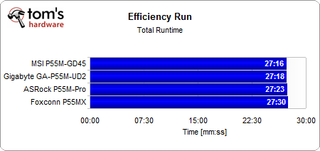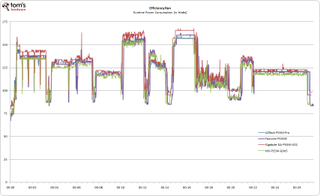Compact P55: Four MicroATX Motherboards Tried And Tested
Benchmark Results: Efficiency
Our efficiency run consists of several applications that we run through a batch script in the following order:
- 3ds Max
- DivX
- Xvid
- Lame
- MainConcept
- PDF Creation
- Photoshop
- AVG Anti Virus
- WinRAR
- WinZip
Some of these applications don’t take advantage of multiple processing cores; others do heavily. The batch file creates time stamps at the beginning of the run and once it has finished. This way, we track the total time required for the test run to complete.
In the meantime, we also track power consumption in one-second intervals during the test run. This lets us shed light on power consumption for each application and create power consumption profiles for each system. The result is a runtime performance score and power consumption readings, which we then use to analyze efficiency. Idle power is taken out of the equation, as the differences are rather small.

Our runtime results shows that the performance differences between all four boards are insignificant. A 14-second difference within a total runtime of more than 27 minutes is certainly too small to declare a winner. However, relating runtime with consumed power results in an interesting efficiency score.

We also provide average power consumption readings for all boards during the efficiency run.

Electricity is typically billed in a certain cost per kWh (kilowatt-hour). Hence, total watt-hours consumed are great for calculating the costs of given workloads and to compare the effective power consumption of boards. The difference between the most efficient and the most power-hungry board is around 5% given our workload.

Our efficiency score relates performance (through runtime) to watt-hours and results in a clear ranking. MSI is first, as you could have already guessed by the power consumption results. Foxconn ranks a respectable second, despite the lack of any power-saving technologies whatsoever. Apparently, the key to being efficient is removing all extra components. ASRock and Gigabyte share the two last spots, although we need to underline that the differences between the four products are not significant.
Stay On the Cutting Edge: Get the Tom's Hardware Newsletter
Join the experts who read Tom's Hardware for the inside track on enthusiast PC tech news — and have for over 25 years. We'll send breaking news and in-depth reviews of CPUs, GPUs, AI, maker hardware and more straight to your inbox.

Current page: Benchmark Results: Efficiency
Prev Page Benchmark Results: Power And Overclocking Next Page ConclusionMost Popular



